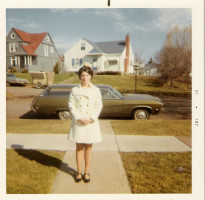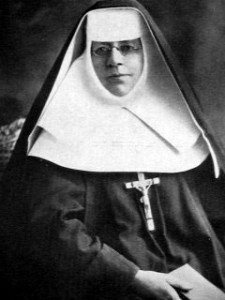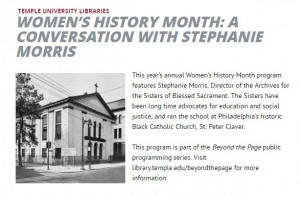For Women’s History Month the National Liberty Museum in Philadelphia, which focuses on documenting important figures in history, advertised an interactive photo exhibit. Their website explains, “From renowned Heroines of Liberty such as Rosa Parks, Eleanor Roosevelt, and Malala Yousafzai, to everyday heroes such as mothers, aunts, colleagues, and neighbors, we invite people to celebrate the heroines in their lives by participating in our interactive photo exhibit.” I was immediately struck by the creativity of this exhibit and it’s potential. It inspired me to ask my own mother about the women in our family and I was amazed to learn that I am a product of four generations of full-time working women. Knowing that these women who came before me found pride and success in their work despite their limitations deeply influenced how I perceive my own value, potential, and work ethic as a woman. Based on my own discoveries, I was thrilled to think that this exhibit could reach people on a large scale, especially young girls. It could show them that average women can make a difference and that women are museum-worthy. It tells younger women that someday, they could be museum-worthy too.
I was immediately struck by the creativity of this exhibit and it’s potential. It inspired me to ask my own mother about the women in our family and I was amazed to learn that I am a product of four generations of full-time working women. Knowing that these women who came before me found pride and success in their work despite their limitations deeply influenced how I perceive my own value, potential, and work ethic as a woman. Based on my own discoveries, I was thrilled to think that this exhibit could reach people on a large scale, especially young girls. It could show them that average women can make a difference and that women are museum-worthy. It tells younger women that someday, they could be museum-worthy too.
Upon entering the National Liberty Museum, I was met with confusion about their women’s history month event. When the museum attendant realized what I was referencing, she pointed me to a small display in the hallway that led into the main exhibits of the museum. She then told me that women’s history did not receive any “special emphasis”, but instead was celebrated throughout the museum. As I approached the interactive photo exhibit, I was disappointed to learn that it was simply 15-20 pictures, many without any textual information, hanging from yellow strings on the wall. There was no sign explaining the exhibit, and I got the impression that most people walk right past it on their way to the museum’s main exhibits without a second glance. While I understand that a lack of submissions could have made this difficult for the National Liberty Museum, there are ways that the museum could have supplemented the submissions with other stories of little known female heroes. Coherent organization and visible text would have also bettered the exhibit because it should have, at least, been distinguishable. In my opinion, this women’s history month event did adequately convey the importance of women in history and society. It felt like they had missed an opportunity to do something really compelling, original, and empowering.
I set off for the rest of the museum, hoping that women’s history would be celebrated throughout as the museum attendant had told me. While the museum did redeem itself in many places, including a small exhibit on women’s suffrage and a blurb about Ida B. Wells, the Lenfest Liberty Hall made me realize how easily women’s history can be neglected for convenience when it becomes problematic. Lenfest Liberty Hall, which is a massive exhibit taking up half of the fourth floor, focuses on the military and those who have received the Medal of Honor. The first red flag about this exhibit was a plaque with 9 pictures under it that read, “Representing Americans of Every Heritage”, and the only person of color was former-congressman Daniel Inouye. The next plaque read, “3428 Recipients Representing All Branches of Service”, and that was when I saw Mary Walker, Civilian Contract Surgeon during the Civil War. She was the only woman on the wall. She was also repeatedly denied a commission in the military, refused help by President Lincoln because of, “controversy on the subject”, and told by the Civil War Medical Board that her skills were, “no greater than what most housewives possess”[1]. After four years of working without pay because of her gender and penchant for wearing pants, Mary Walker finally got her commission in 1864. That spring, she was captured by the confederate army and spent five months as a prisoner of war. For this, and for her committed work as a skilled surgeon, Mary Walker was awarded a medal of honor in 1865, only to have it taken away later in life because according to officials she had never seen actual combat[2]. Defiantly, Mary Walker wore the medal until the day she died. None of her amazing story, however, was on the wall. Her struggle to get and to keep the Medal of Honor that she had earned was reduced to her name and title. It has the potential to, but still says nothing about the rampant sexism she faced military or the fact that she remains the only woman to have ever received the Congressional Medal of Honor. I was not presented with the story of Mary Walker that sheds light on the social and political climate during the war she was in, but instead given the simple and false impression that women were included in the legacy of the Medal of Honor.
I was reminded of Alice Kessler-Harris’ article discussing the need for women’s history, when she explains, “By illuminating the lives of women, we would enable to historical profession to see more deeply into the psychic and social arrangements that undergirded political decision making and economic and cultural organization”.[3] There have always been women doing remarkable and important things, yet they are often neglected in the historical discourse. Incorporating women into the public history gives a fuller and richer understanding of the past itself. I kept coming to the question of why women make up about half of the population, yet people seem to feel that they don’t deserve half of the museum. At Temple University, Women’s history fulfills a diversity requirement. This baffles me. Women are not the minority, yet they remain in the margins of scholarship, even in our most enlightened institutions like museums and universities. Addressing women’s history in a comprehensive way and incorporating it into the mainstream, especially when it becomes problematic or uncomfortable to talk about, presents the public with a history that is not only more compelling and inclusive, but also more true.
[1] Rehmen, Atiq, Naba Rahman, Sharon Harris, and Faisal Cheema. “Mary Edwards Walker: A Soul Ahead of Her Time.” Journal of the American Medical Association 150, no. 2 (December 23, 2013): 173.
[2] Rehmen, Atiq, Naba Rahman, Sharon Harris, and Faisal Cheema. “Mary Edwards Walker: A Soul Ahead of Her Time.” Journal of the American Medical Association 150, no. 2 (December 23, 2013): 173.
[3] Kessler-Harris, Alice. “Do We Still Need Womens History?” The Chronicle of Higher Education 52, no. 15 (December 7, 2007).


